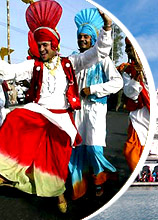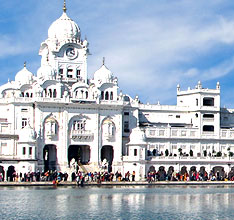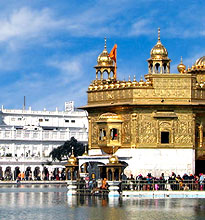 Sheesh Mahal, or the Palace of Mirrors, is one of the popular tourist attractions of Patiala. It flaunts the ostentatious grandeur of the royal Maharajas. The palace has been named so, owing to its exquisite interior that is completely ornate with mirrors and glasses, along with the pretty floral motifs painted on the walls. There are grand mural paintings therein, most of which portray themes from mythology and religion. Sheesh Mahal also depicts some of North India's best classical poetry, especially that of masters like Surdas, Keshav Das and Bihari Lal.
Sheesh Mahal, or the Palace of Mirrors, is one of the popular tourist attractions of Patiala. It flaunts the ostentatious grandeur of the royal Maharajas. The palace has been named so, owing to its exquisite interior that is completely ornate with mirrors and glasses, along with the pretty floral motifs painted on the walls. There are grand mural paintings therein, most of which portray themes from mythology and religion. Sheesh Mahal also depicts some of North India's best classical poetry, especially that of masters like Surdas, Keshav Das and Bihari Lal.History
Sheesh Mahal was built by Maharaja Narinder Singh (1845-1862), behind the main Moti Palace. He was known to be a great patron of art and literature. The palace was built in a forest, with terraces, gardens, fountains and an artificial lake. It is a sprawling three-storied building, part-European and part-Mughal in appearance, supposedly modeled on Lahore's Shalimar Bagh. The palace has a suspension bridge very similar to the Lakshman Jhoola at Rishikesh. Standing for the culture of Punjab, Sheesh Mahal is a part of the Qila Mubarak.
Attractions
Painters from Kangra and Rajasthan were employed to paint the walls of Sheesh Mahal. There are a variety of images engraved on the palace walls, pertaining to literature, mythology and legends. These paintings convey Raga-Ragni, Nayak-Nayika and Bara-Masa, in Rajasthani style. The prime attractions of the Sheesh Mahal are the series of Kangra-style miniatures, depicting Geet Govind, an epic poem by Jaidev. The Kangra paintings, depicting Lord Krishna Lila, reflect the highest degree of professional and delicate taste. Besides paintings, you can explore the artistic gallery of Tibetian sculpture here. Ivory carvings of Punjab, royal wooden carved furniture and a large number of Burmese and Kashmiri carved objects are also presented. The palace is rich with portraits of the rulers of Patiala, rare Janamsakhi manuscripts & Jain manuscripts.
Medal Gallery
Sheesh Mahal has an exclusive exhibition of a large number of medals in its Medal Gallery. There are as many as 3,200 medals that were collected by Maharaja Bhupinder Singh from all over the world. His son, Maharaja Yadvindra Singh gifted the priceless collection to Punjab Government Museum. Some of the important medals seen here are The Order of the Grater (England, 1348 A.D), Golden Fleece (Austria, 1430 A.D), St. Andrews (Russia, 1688), and The Order of the Rising Sun (Japan). Besides the medals there is also a rare collection of coins. This collection consists of a vast range from the punch-marked coins issued by the princely states in the 19th century. The palace is a galaxy of art and culture, displaying antique paintings, bronzes, sculptures and portraits of the Maharajas of Patiala as well.











